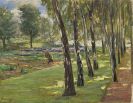
Walter Leistikow
1865 Bromberg
1908 Berlin
Walter Leistikow was born second of nine children on October 25, 1865. His father was an apothecary and merchant. At the age of 17 Walter Leistikow decided to become an artist. For this aim he went to Berlin in 1883 and attended the academy, however, due to a lack of talent he was soon dismissed. As a consequence he took private painting and drawing lessons with the two landscape painters Hermann Eschke and Hans Gude until 1887. In 1886 Walter Leistikow successfully showed his paintings at the Berlin Salon. Walter Leistikow was part of a group of artists that followed latest modern tendencies. In 1892 he was one of the founding members of the artist group “Die XI“. In 1897 Walter Leistikow met Lovis Corinth in Berlin, the two artist became close friends. Lovis Corinth wrote a book about his friend which was posthumously published by Paul Cassirer (L. C., Das Leben Walter Leistikows - Ein Stück Berliner Kunstgeschichte, Berlin 1910.).
Walter Leistikow played a key role in the formation of the Berlin Secession in 1898, the rejection of one of his paintings by the jury of the ‘Große Berliner Kunstausstellung‘ was the straw that broke the camel‘s back, sparking protest among modern artists against the academy‘s regimentation. Walter Leistikow went on numerous journeys to Paris, Scandinavia and Italy. His knowledge of French Impressionism, as well as of van Gogh and the Norwegian Edvard Munch was decisive for the Berlin art world.
His own work also saw a temporary period of symbolist creation which would influence coloring and line management of later works. The increasing decorative stylization brought Walter Leistikow closer to applied arts. An increasing rejection of Art Nouveau can be observed for the last years of his artistic creation as of 1900. He turned to plein-air painting instead. Apart from paintings he also left a vast graphic oeuvre behind.
Together with Harry Graf Kesler and others Walter Leistikow founded the ‘Deutsche Künstlerbund’ in Weimar in 1904. In recognition of his accomplishments the Berlin Academy appointed him professor in 1907. Today Walter Leistikow‘s works are on display at many museums and collections in Germany and abroad.
After agonizing years of a syphilis illness his life was beyond all bearing and Walter Leistikow committed suicide.
On occasion of his 100th day of death in 2008 the Bröhan Museum in Berlin showed a comprehensive retrospective.

Would you like to sell a work by Walter Leistikow?
Infos for sellerART MARKET:

Die Birkenallee im Wannseegarten
Oil on canvas, 1919
Post-Auction Sale 400.000
More offers >






